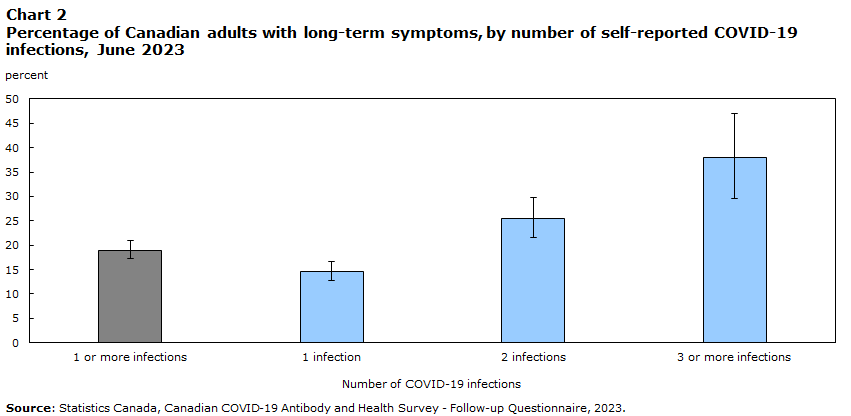
Published: May 28, 2024 at 8:05 PM
By: Gregory Kirchoff, Arijit Chakravarty
Understanding Cumulative Risk
When people say “during Covid”, they're referring to the pandemic in the past tense, something that's already over, despite the fact that the WHO still regards Covid-19 as an active pandemic. At this point, we have gone back to “living our (pre-pandemic) lives”, which - for most - means taking no precautions at all.
It has become apparent that without decisive mitigation becoming established through government and societal action, most of us will continue to get infected with SARS-CoV-2, likely once or twice a year. Because some of the health risks of Covid are irreversible, it's worth digging a little deeper into the practical implications of that.
The first thing to know is that Covid is not a cold, it's a car accident. It spreads throughout the body, impacting many different organ systems. Some percentage of people who get Covid end up with Long Covid, a debilitating cluster of symptoms that involves fatigue and reduced cognitive ability. Some percentage of people who get Covid end up harboring the virus in their bodies persistently (this may or may not overlap with Long Covid). Separate from those two categories of delayed harm, many individuals infected with Covid have delayed health effects (heart attacks, strokes, kidney damage) that are in some cases progressive. It's not unusual to get into a car accident and be just fine, but a lifestyle that involves getting into a car accident once a year comes with a reduced life expectancy.
This makes sense if we think about it from the concept of cumulative risk. Much of the argument around Covid has centered around the persistent robustness of our immune response, neglecting the persistent damage that infection can cause.
To understand this, we need to understand cumulative risk. This concept is simple to understand, but is often misinterpreted. According to data gathered by Statistics Canada, the risk of developing symptomatic Long Covid is around 15% per infection. This makes perfect sense when looking at one infection. Your chance of developing symptomatic Long Covid is 15%. However, what is the chance from 3 infections? Does the overall chance remain 15% because each infection has a 15% chance, or is the overall chance 45% from adding them all up? The answer is about 38.6%.
To explain this in the context of COVID-19, the default value for this interactive guide is 15%, but adjust it to any number between 0 and 100% to gain a better understanding of how this works.
For the rest of the article:
The chance of getting symptomatic Long Covid is %
We want to know the probability of having contracted Long Covid after infections
The final question we want answered is, “What is the overall chance I get Long Covid if I get infected 3. times?" A simpler way to think of this at first is , “If I flip a coin 3 times, what is the chance that at least 1 of them lands heads up?” It could be 1 or 2 or 3 times for example, just as long as at least 1 coin lands heads up.
Going back to Long Covid as our primary example, our next question to ask is, “What is the chance I get infected 3 times and don't get any Long Covid?” This is important to ask because this is the only combination of results that doesn't include any Covid cases resulting in Long Covid. Let's find that.
The chance of NOT getting symptomatic Long Covid from an infection is:
1 -0.15 = 0.85 Which is 85%.
The formula to find the chance that something occurs n times is (p)^n where p is the probability of the event occurring and n is the number of “successes” we are expecting.
So, the chance that someone gets infected with Covid 3 times and hasn't gotten symptomatic Long Covid from any of them is:
(0.85)^3 = 0.61 which is 61.41%
There is a 61.41% chance that someone doesn't get Long Covid after having been infected 3 times. In order to know the chance of getting Long Covid from at least one of these infections, we want to know the chance that this DOESN'T happen. For that, you simply subtract this from 1:
1 - 0.6141 = 0.3859 = 38.59%
So there we have it. Assuming Covid infections come with a 15% chance of getting Long Covid each time, getting Covid 3 times results in a cumulative risk of getting Long Covid of 38.59%.
Note that if you made the chance of getting Long Covid 14% per infection, the result of 1, 2, and 3 infections tracks remarkably close with the population data gathered by Statistics Canada.

This interactive chart below makes an important practical point: should the data found by Statistics Canada be indicative of a cumulative risk pattern, getting Long Covid becomes an inevitability.
Getting Covid repeatedly is not a game we can win in the long-term. Like playing roulette, we can win a game, maybe even a few, but given enough chances, the house always wins. The good news is that you don't have to sign up for getting Covid once a year. There are things you can do to avoid that. And if you do get Covid, there are concrete steps you can take to reduce the risk of long-term health outcomes.
“Learning to live with Covid” should mean learning to live our lives while rationally mitigating the ever-present risks of an airborne disease with debilitating consequences. Not learning to live while harboring the virus, or the scars it leaves, in our bodies.